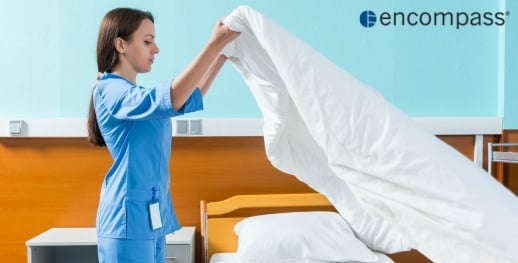Though many understand the impact linens have on resident comfort, be sure your team also recognizes the impact of linens on resident safety. Here are 4 ways to ensure your laundry process is helping to prevent infection.

Improve infection control during linen handling
Controlling the spread of infection and superbug outbreaks can be a matter of life and death in the healthcare industry. Should your senior living facility encounter a linen-related infection control issue, you don’t want your linen handling protocol to be the culprit.
Here are four steps your facility’s environmental service (EVS) director should evaluate when assessing your linen handling procedure:
Four steps to help your staff follow the CDC guidelines for laundering linens
- Safely removing and transporting soiled laundry: Used linens should be safely removed from the resident bed and placed directly into a container or bag that can be closed or otherwise secured to prevent the spread of microorganisms.
Although every facility has a different washing procedure, sorting linen before washing reduces the potential for recontamination of clean textiles. RLS includes hamper carts that make it easy to safely bag soiled linens immediately after removing them from resident beds. The color-coded bags offer an easy way to sort linens, and the snug-fitting lids prevent cross-contamination during the transfer from resident rooms to the laundry. - Washing and drying: The combination of mechanical, thermal, and chemical factors is what effectively cleans and removes microbes from soiled laundry during the washing process. The scrubbing action of the water and the machine agitate microorganisms while laundry soaps, detergents, and bleach (when necessary) help remove and lift away the pathogens from the linens. Using hot water at a temperature of 160°F (71°C) for a minimum of 25 minutes is commonly recommended for hot-water washing; this method provides an effective means of destroying the microorganisms. The fabric will dictate dryer temperatures and cycle times.
Commercial laundering can be harsh on linens. RLS products have a life expectancy of up to 4 times longer than comparable products, reducing replacement costs up to 40%. The stain-resistant products rarely require re-washing, and the innovative product materials reduce standard drying times up to 50% compared to traditional linens. - Sorting and folding: After they are washed and dried, cleaned and dried linens are often pressed, folded, and packaged for transport back to resident floors. Though pressing and folding reduces wrinkles and creases in cotton linens, it can be a time-intensive step in the laundry cycle.
- Transporting and storing: RLS was designed to simplify this part of the process. 60% of the system’s products do not require ironing or folding, eliminating the need for a flat work ironer, small piece folder, and related staff activities. The easily identifiable products reduce sorting time and improve efficiencies when separating for transportation and storing.
When combined, the increased efficiencies of RLS reduces linen processing costs up to 35%!
Most importantly, resident safety is always top-of-mind for senior living facilities, and it was top-of-mind during the development of RLS. Not only is the RLS designed to simplify the safe linen handling process, but it also includes moisture-wicking textiles and pleated top-sheets to protect immobile residents while they rest.
Is your facility looking for a simple way to improve resident care? Email or call me today at 1-800-328-5525 to discuss in more detail about how Revolution Linens can help you increase infection prevention efforts through proper linen handling at your facility.

